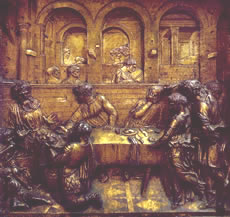The Art of Perspective
For my inaugural "Perspective" blog I have put in a little extra effort by giving examples of perspective in art and in telecom.
“Perspective is the bridle and rudder of painting”
Leonardo da Vinci
The medieval town of Siena is built on three hills in heart of beautiful Tuscany, Italy. With its central Piazza del Campo and gothic churches, it’s a must-see for anyone interested in culture and architecture. Siena is also the home of world-famous annual bare-back horse races (“Palio”), in which seventeen city boroughs (“contrades”) contest each other every summer.
Much less known is the revolution in the world of art caused by one small bronze panel in this city. The panel is named “Feast of Herod” and is located in the Baptistry Font of the Siena cathedral. It was made by one of the world’s most important sculptors: Donatello (1386 - 1466).
 |
Created in the early 1420’s, it is ground-breaking by its first proper use of linear perspective. The bold technique of Donatello’s bronze panel opened a new era: The wave of perspective rushed through the world of art and within few years, all artists adhered to its principles. For the next five hundred years, nothing changed. Where, prior to Donatello’s panel, no one questioned the incorrect perspective in paintings (a combination of absence of world-view and technical knowledge), the rules of perspective remained unchallenged up to the early twentieth century. |
It was only one century ago when a young artist stepped off the trodden path and challenged the traditional use of perspective. |
 |
How does this relate to telecommunications, one may ask? Well, in physics, perspective is described as an optical projection of light rays: an optical transform.
The first ever transatlantic subsea telegraph cable was laid in1858 by a private enterprise. It was perceived as the wild project of a “Yankee-lunatic”. The impact on the world was immense. By the early 1900’s, regulatory structures had been established by most nations to safeguard international telegraph revenue streams. The resulting bandwith colonialism by consortiums of incumbents building international cables stayed in place for almost one hundred years.
Ten years ago, another “Yankee-lunatic” stepped off the trodden path and challenged the high rates of club cables by privately building an optical transatlantic cable and cable stations (after struggling with lawyers on understanding monopolistic regulations for almost a year). Global Crossing’s new vision, with its (too) many followers, permanently changed the global telecommunication and internet business.